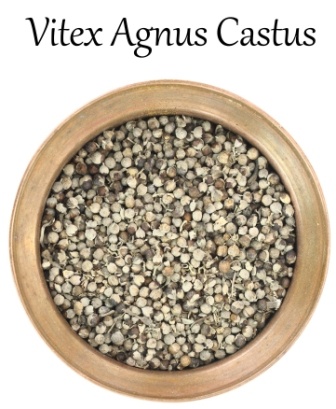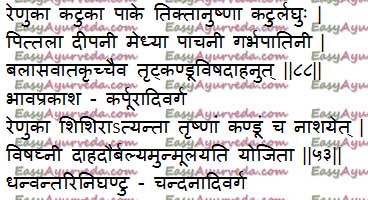Chasteberry Vitex agnus-castus: Indications, Qualities, Research
By Dr Renita D’Souza
Chasteberry (Vitex agnus-castus Linn) is an Ayurvedic herb which is carminative in nature. It is used to treat poisoning, itching, burning sensation, excess thirst, weakness etc
Botanical Name – Vitex agnus-castus
Family – Verbenaceae
Table of Contents
Qualities, uses, part used
Medicinal Qualities of Renuka
Rasa (taste) – Katu (pungent), Tiktha (bitter)
Vipaka – Katu – It undergoes pungent taste conversion after digestion.
Virya (potency) – Anushna – slightly hot potency
Guna (qualities) – Laghu (light to digest)
Karma (actions) –
Pittala – increases Pitta Dosha
Deepani – Carminative
Pachani – Improves digestion
Medhya – improves memory, intelligence
Garbhapatini – Induces abortion
Indications of Renuka
Trit – excess thirst
Kandu – itching
Visha – toxic condition, poisoning
Daha – burning sensation
Dhaurbalya – weakness
Mukha vaimalya karini – cleanses the oral cavity
Effect on Tridosha
It increases pitta.
Balances Kapha and Vata dosha.
Part used – Seed, Leaves, Root

Distribution, Sanskrit verse
Distribution
Vitex agnus-castus is found in Western Asia, Southwestern European territories.

Interaction with medicines, supplements
Can this be used while taking Homeopathic medicine?
Yes. This product does not react with homeopathic medicine.
Can
this medicine be continued while taking supplements like multivitamin tablets,
Omega 3 fatty acids etc?
Yes. Generally, this product goes well with most
of the dietary supplements. However, if you are taking more than one product
per day, please consult your doctor for an opinion.
With western
medicines
Seek your
doctor’s advice if you are taking this product along with other western
(allopathic / modern) medicines. Some Ayurvedic herbs can interact with modern
medicine.
If both Ayurvedic and allopathic medicines are advised together, then it is
best to take Allopathic medicine first, wait for 30 minutes and then take the
Ayurvedic medicine.
Chemistry, medicine, research
Chemical compounds of Vitex agnus-castus –
Vitexin, casticin, agnuside, aucubin, p-hydroxybenzoic acid, alkaloids, essential oils, fatty oils, diterpenoids and steroids.
In Sushrutha Samhita renuka is included in Eladi ghana. It is also mentioned in treatment of fistula, sinus, ulcers and poisoning.
In Charaka Samhita it is mentioned as one among the herbs used for herbal smoking therapy (prayogika dhumapana), also mentioned in the formulations such as Mritha sanjivini Agada used to treat poisoning and Madhvarista used in Grahani (IBS).
Ayurvedic Medicines with Renuka Ingredient
Mahayograj Guggul – It is a well known Ayurvedic medicine in tablet form widely used in the treatment of joint diseases, skin diseases, piles, diabetes, gout, fistula, emaciation, low digestion, asthma, cough, male and female infertility etc
Balaswagandhadi Thailam – Ayurvedic oil used to treat headache, fever, emaciation, muscle wasting, lack of strength in joints, muscles and bones.
Bala Tel – This oil is used both externall and internal in conditionss such as cough, cold, fever, vomiting, bloating, wound, emaciation, spleen diseases, epilepsy, asthma.
Vasachandanadi Taila – Used in cough, cold, asthma, bronchitis, fever, bleeding disorders, anemia, jaundice, tuberculosis, Chest injury, weakness and emaciation.
Mathala Rasayanam – It is an Ayurvedic medicine in herbal jam form, used in digestive and respiratory diseases
Tutthadi Lepa Churna – It is in powder form applied locally in the form of paste to treat poisonous bites and wounds.
Research on Chasteberry
1. Use in Premenstrual syndrome – A study conducted on use of Vitex agnus castus to treat premenstrual symptoms have concluded the significant effect of dopaminergic compounds present in Vitex agnus castus in relieving premenstrual mastodynia and other psychic and somatic symptoms of premenstrual syndrome.
2. Use in PCOS – Vitex is known to reverse hormone imbalance and hence useful in treating PCOS. It is known to improve progesterone secretion. Hence used in correction of luteal phase of menstrual cycle.
Another research indicates that vitex is useful to improve progesterone and treat atrophic endometrium.
3. Anti- Angiogenic Activity – Research conducted on anti- angiogenic activity of Vitex agnus castus methanol extract in vivo have proved its ability to block the VEGF-receptor, thereby inhibiting the angiogenesis process (growth of new blood vessels).
Categorization, vernacular names
Classical catergorisation
Bhavaprakasha Nighantu – Karpuradi Varga
Raja Nighantu – Pippalyadi Varga
Dhanvantari Nighantu – Chandanadi Varga
Kaiyadeva Nighantu – Aushadi Varga
Shodala Nighantu – Chandanadi Varga
Vernacular Names
Hindi Name – Renuka, Renuk
Gujarati Name – Harenu
Marati Name – Renuka beej
Arabic Name – Athalak
English Name – vitex, chaste tree
Morphology, controversy, synonyms
Morphology of Vitex agnus-castus
Vitex agnus-castus Linn is a small tree with violet colour fragrant flowers. Digitate leaves with five or seven leaflets. Fruits are oval shape and brown in colour.
Controversies
Seeds of Nirgundi – Vitex negundo are used in the name of renuka seeds as a substitute.
Sanskrit Synonyms
Renuka, Rajaputri, Nandini,
Kapila, Dvija,
Bhasma gandha, Panduputri,
Kaunti, Harenuka
Click to Consult Dr Renita D’Souza










2 comments
marissa
Namaste. Thank you for your article. I am curious about the uses of Vitex with men and women–previous studies have indicated to me that while the seeds can have the effect of helping hormone levels in women to come into balance, they have the effect of testicular atrophy in men. The primary way that I have seen this herb used in Western Herbalism is as a tonic herb for women, but you seem to be indicating here that it is utilized quite differently in Ayurveda.
Dr J V Hebbar MD(Ayu)Author
What you have said is correct. Vitex is in deed useful to improve progesterone and thus is used in treating PCOS and female infertility.
Regarding its action on testicular atrophy, I did not find conclusive evidence.
Please note, Ayurveda considers the herb as a whole and not as single chemical extracts.